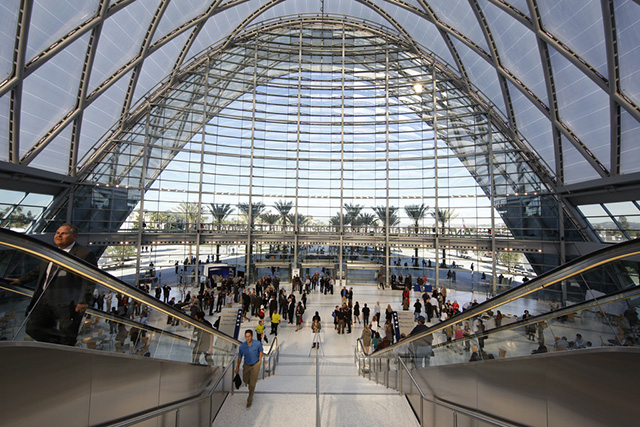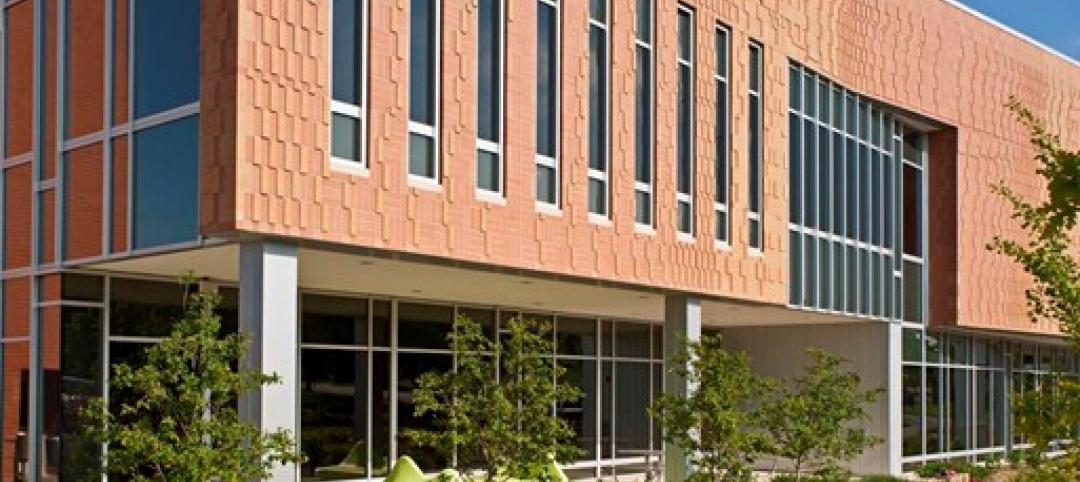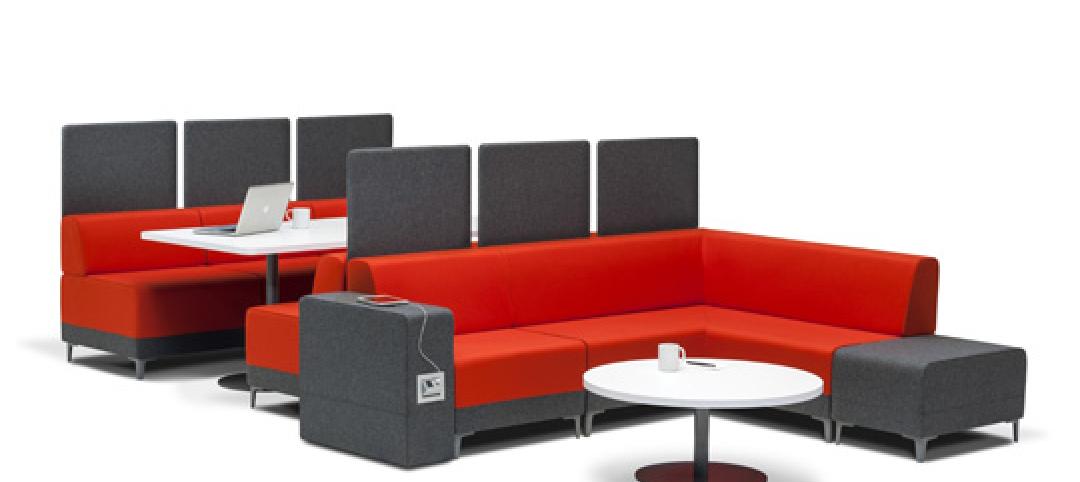The new Anaheim Regional Transportation Intermodal Center (ARTIC) sets a precedent for civic-minded transit hubs in the United States. HOK designed ARTIC, which represents the next generation of public transportation in Southern California, as an innovative new transit station that serves as a destination in itself. The grand opening ceremony for the community was on Dec. 13.
“ARTIC is a community-focused building that will change how people think about public transportation,” said Ernest Cirangle, FAIA, LEED AP, Design Principal for HOK’s Los Angeles office. “This iconic facility is a symbol of a new era of public transit and was only made possible because of city leaders’ unwavering commitment to a contemporary and bold design.”
Projected to serve the transportation needs of more than three million people annually in the coming years, the 67,000-sf transit hub links commuter and regional rail service and intercity bus systems including Amtrak, Metrolink, OCTA bus service, Anaheim Resort Transportation (ART), Megabus.com, and Greyhound.
ARTIC’s flexible design ensures that it can serve as a southern terminus for California’s future high-speed rail system. In addition to accommodating passenger arrivals, departures and transfers, ARTIC integrates amenities such as transit-oriented retail, Wi-Fi and charging stations, parking, bike racks, lockers, community space and specialty dining.
HOK won an international competition to design the project. Officials challenged the team to create an icon that would welcome a new age of public transportation into the region. The station also was conceived as a catalyst for transforming Anaheim’s core into a pedestrian-friendly zone that promotes connectivity and a vibrant, mixed-use environment. Known as the “Platinum Triangle,” the area around the station includes destinations such as Angel Stadium, the Honda Center, the HOK-designed Anaheim Convention Center and nearby Disneyland.
“The master plan establishes a clear pedestrian pathway flanked by future, mixed-use development with ARTIC as the primary destination,” said Cirangle. “The extroverted building has a significant but welcoming presence and will help spur transit-oriented development.”
Drawing inspiration from classic grand transit halls including Grand Central Terminal in New York, along with the structural elegance of local airship hangars, the team developed a 21st-century design concept for the forward-looking transit facility. The design achieves ARTIC’s signature parabolic form by employing a diagrid structural system of diamond-shaped steel arches infilled with translucent ETFE (ethylene tetrafluoroethylene) pillows. At the north and south ends, freestanding curtain walls bring in daylight and open the building to views. The long-span, grid shell structure creates a grand, light-filled atrium space that accommodates open circulation.
The design team used building information modeling (BIM) to develop ARTIC’s complex form, geometry and functions, to navigate the complexities of the building systems, and to study the building’s tolerances and environmental performance. “By using BIM, we were able to optimize and coordinate the precise geometry of the vaulted diagrid shell, ETFE facade technology, metal panel rain screen systems and glass,” said Albert Kaneshiro, AIA, LEED AP, HOK’s project manager. “BIM allowed us to match ETFE connections with the geometry of the steel in a structure that is constantly expanding and contracting.”
Based on the city’s goals for sustainability, the team designed ARTIC for U.S. Green Building Council LEED Platinum certification. The vault-shaped structure acts in concert with advanced mechanical systems to optimize energy efficiency. Inflated ETFE cushions cast a soft, translucent light throughout the great hall, while the additional frit pattern on the outer layer reduces solar heat gain. Convection currents naturally ventilate the building as heat rises from the lower south end up to the north side and out through operable louvers. The radiant heating and cooling floor system and optimized HVAC system will help reduce ARTIC’s energy consumption by 50 percent.
LEDs mounted on the diagrid structure illuminate the ETFE pillows in gradations of shifting colors, providing a striking presence on the night skyline. As darkness falls, ARTIC becomes lit from within and acts as a beacon from the freeways and local streets.
HOK provided architecture, interior design, master planning and urban design services. Parsons Brinckerhoff was the project manager and served as the rail and civil engineer. Other consultants include Thornton Tomasetti as structural engineer, Buro Happold as MEP and enclosure engineering, SWA as landscape designer, and Clark Construction as general contractor.
Related Stories
| Jul 7, 2014
7 emerging design trends in brick buildings
From wild architectural shapes to unique color blends and pattern arrangements, these projects demonstrate the design possibilities of brick.
| Jul 2, 2014
Emerging trends in commercial flooring
Rectangular tiles, digital graphic applications, the resurgence of terrazzo, and product transparency headline today’s commercial flooring trends.
| Jun 30, 2014
Arup's vision of the future of rail: driverless trains, maintenance drones, and automatic freight delivery
In its Future of Rail 2050 report, Arup reveals a vision of the future of rail travel in light of trends such as urban population growth, climate change, and emerging technologies.
| Jun 18, 2014
Arup uses 3D printing to fabricate one-of-a-kind structural steel components
The firm's research shows that 3D printing has the potential to reduce costs, cut waste, and slash the carbon footprint of the construction sector.
| Jun 12, 2014
Austrian university develops 'inflatable' concrete dome method
Constructing a concrete dome is a costly process, but this may change soon. A team from the Vienna University of Technology has developed a method that allows concrete domes to form with the use of air and steel cables instead of expensive, timber supporting structures.
| Jun 2, 2014
Parking structures group launches LEED-type program for parking garages
The Green Parking Council, an affiliate of the International Parking Institute, has launched the Green Garage Certification program, the parking industry equivalent of LEED certification.
| May 29, 2014
7 cost-effective ways to make U.S. infrastructure more resilient
Moving critical elements to higher ground and designing for longer lifespans are just some of the ways cities and governments can make infrastructure more resilient to natural disasters and climate change, writes Richard Cavallaro, President of Skanska USA Civil.
| May 23, 2014
Top interior design trends: Gensler, HOK, FXFOWLE, Mancini Duffy weigh in
Tech-friendly furniture, “live walls,” sit-stand desks, and circadian lighting are among the emerging trends identified by leading interior designers.
| May 20, 2014
Kinetic Architecture: New book explores innovations in active façades
The book, co-authored by Arup's Russell Fortmeyer, illustrates the various ways architects, consultants, and engineers approach energy and comfort by manipulating air, water, and light through the layers of passive and active building envelope systems.
| May 19, 2014
What can architects learn from nature’s 3.8 billion years of experience?
In a new report, HOK and Biomimicry 3.8 partnered to study how lessons from the temperate broadleaf forest biome, which houses many of the world’s largest population centers, can inform the design of the built environment.

















